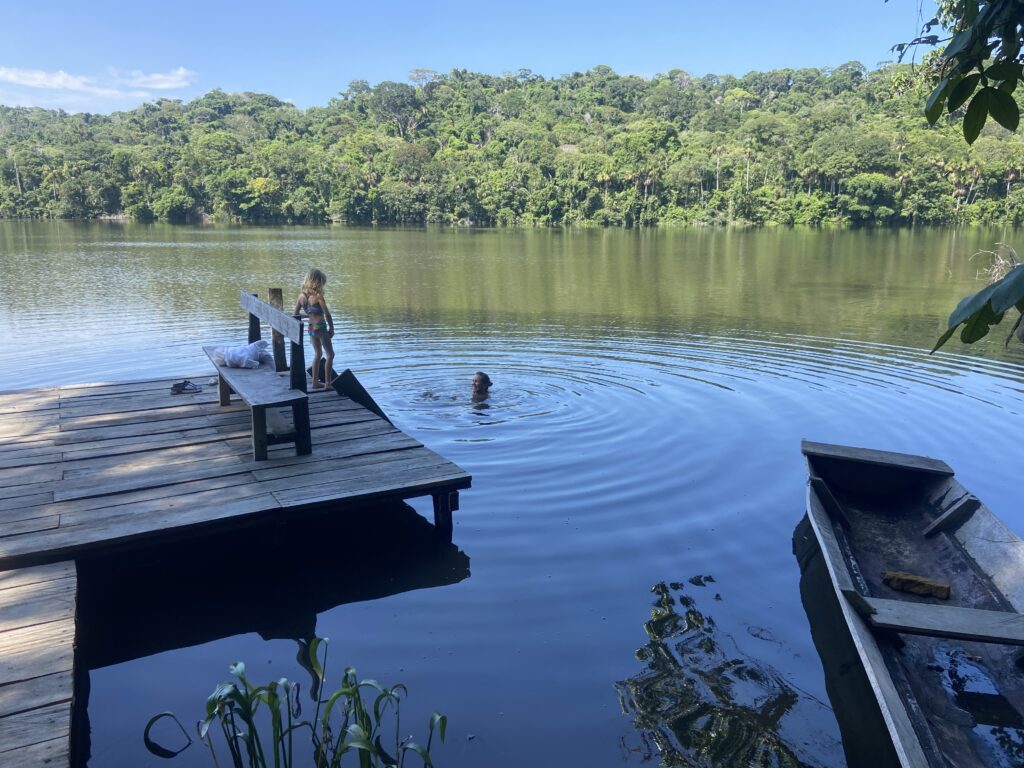“Todo es posible. Nada es segura.”
I heard the snorts first, echoing like gunshots through the sauna-thick air. Then I saw heads jack-in-the-box out of the lake, right off the bow of our wooden canoe. “Giant river otters!” whispered our guide, Gilder.
Two, four, eight otters zig-zagged near the lush bank, deep in the Bolivian Amazon. Lyra chuffed back at them, her eyes glued to the furry visitors. Gilder paddled beneath an overhanging branch, giddy with excitement. “We’ve never seen this many at Chalalan.”




The two-meter-tall mammals — the world’s largest otters — nearly went extinct due to people hunting them for their fur. The Indigenous community that Gilder hails from, San Jose de Uchupiamonas, helped bring them back by protecting their habitat at Chalalan Ecolodge in Madidi National Park, both of which were created in the mid-1990s.
Our family visited Chalalan for five days. Other than one other woman from the Netherlands, we had the lodge’s jungle trails and glittering lake all to ourselves. Most people don’t visit the Amazon during the summer rainy season. I was hesitant to go at first, worried about mosquitoes and heat. But it was one of the most magical places I’ve ever been.
The adventure began with two (delayed) flights from Sucre to Cochabamba to Rurrenabaque, which is a small, extremely hot town on the edge of the Rio Beni, the southeastern-most headwaters of the Amazon River. The next morning we piled into a long motorized canoe for a six-hour boat ride upriver in the pouring rain.






Once we “docked” the boat on a muddy bank, we backpacked one mile into the ecolodge, stopping to gawk at jaguar tracks along the way. Gilder showed us how the leaves near the tracks smelled like jaguar pee, a sign that the female using the trail was ready to mate.
Our smiling housekeeper/waitress, Jovanna, met us with a glass of fresh lemonade and showed us our cabin: a simple, screened-in wooden building with twin beds and mosquito nets, as well as a private bathroom.
We hiked a couple times each day with Gilder, then canoed a lap around Chalalan Lake in the evening. The otters graced us with their snuffling presence each time. So did a few caiman. Notably absent, however, were the mosquitoes. We got way more bug bites in other parts of Bolivia than in the jungle!





Madidi National Park is thought to be the most biodiverse place on the planet. Based on the clouds of butterflies that swirled through Chalalan, we would agree. The kids chased them for hours. The variety of ants and spiders was also impressive — and alarming at first. But like most uncomfortable things in life, you get used to them once you live with them for a while. My worry turned to wonder remarkably fast.
We saw incredible birds, like the prehistoric huaxín, a turquoise-and-peach agami heron, kingfishers, macaws, parrots and more. Common yellow squirrel monkeys, red howlers and capuchin monkeys leapt in the branches overhead. We saw crabs and turtles emerge on a particularly rainy day. A night walk revealed fireflies, the biggest frog I’ve ever seen (with blueish legs!), a mom and baby tarantula, a rainbow boa, and THOUSANDS of fish spawning in a tiny creek (where a 9-foot caiman was chomping on them).





We learned about trees that taste like garlic, and trees that make rubber, and trees that are 95% water. We sucked the liquid from the butt of a queen leaf-cutter ant (“Tastes like butter!” exclaimed Talon.) We learned to spot the giant bullet ants before we stepped on one (whose bite supposedly feels like getting shot), and how to repel mosquitos by blowing through a bamboo leaf to mimic the sound of a predatory fly. I swam one day in the murky, caiman-filled lake, the water so warm it felt like a bath. And, yes, I stayed VERY close to the dock.
On the last morning, we asked the guides what the odds were of seeing a jaguar on the boat ride back to Rurrenabaque. Gilder downed his papaya juice, then grinned at us. “Todo es posible. Nada es segura.”


